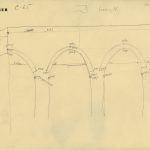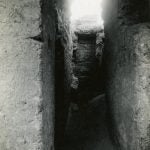From the Archives — June 2016
Apologies for the tardiness of this post …
BY SEBASTIÁN ENCINA, Museum Collections Manager, Kelsey Museum of Archaeology
Though the summer months see a drop in university class visits to the Kelsey, the museum is by no means less busy when classes are not in session. Researchers who are students and professors here at Michigan, or at other universities around the world, take a break from their teaching responsibilities and make their way to the field and museums to continue their research. The Kelsey hosts a fair number of these scholars. Projects we did not have time for during the academic year are saved for the slower summer months.
As to be expected, the site of Karanis garners much attention from researchers. Every year we have numerous people come to study our collections on this Graeco-Roman site, or the archives that still contain a depth of information waiting to be revealed. This summer is no different, as Karanis has been the focus of an ongoing trial investigation by a group of Michigan scholars. Headed by Dr. Arthur Verhoogt (Classics) and Dr. David Stone (Kelsey Museum), a team has been assembled to determine what it would take to finally digitize, in a controlled and consistent manner, the entirety of Karanis holdings. This includes all the artifacts excavated at Karanis and brought to Michigan, but also all the maps, and archives, and photographs. Over the years, we’ve digitized some of the items, but only specific ones and only as requested.
This team, which also included graduate students Alexandra Creola (IPCAA), Caitlin Clerkin (IPCAA), and Lizzie Nabney (Classics), undergraduate students Emily Lime (Classics) and Mollie Fox (History of Art), professors Brendan Haug (Classics) and Laura Motta (Kelsey Museum), staff Sebastián Encina (Kelsey Museum) and Monica Tsuneishi (Papyrology), has decided to approach the site in a new manner. Previous research and publications have focused on material types. We have publications on the coins of Karanis, or the pottery, or papyrus. Instead, Drs. Stone and Verhoogt want to look at the context of the finds. How did the papyrus relate to coins found within the same space? What does a figurine found alongside a spindle whorl tell us about the inhabitants of house C56?
Over the past two months, students Mollie and Emily have been busy finding, cataloguing, and digitizing items from two contexts, C65 and C137. The team decided to focus on these two structures as they seemed of great interest due to their contents, and also because for a two-month trial project, looking at anything more would have been impossible. Mollie and Emily spent time going through the archives and identifying materials that related to these two structures (one house and one granary). They were then pulled, entered into a project-specific database, and eventually scanned or photographed. Among these was a 32-foot-long map that showed a cross section of Karanis which we are excited to finally have scanned!
The project was generously supported by the Michigan Humanities Collaboratory, an endeavor funded by the Office of the Provost that seeks to bring together people from separate departments to work together towards a single goal. Several projects were funded for this summer term, including this Kelsey-Classic-Papyrology project. We hope to turn this trial period into a much bigger one, where the entirety of Karanis materials are digitized and made available to researchers freely. By doing so, researchers can approach the materials in their own way, without hindrance. At the conclusion of the two year project, we will have a better understanding on what we have here in Ann Arbor, a web portal will be in place for ease of research, and there may be publications and an exhibition. While students continue to digitize and catalogue, graduate students and faculty will analyze the materials to make better sense of the spaces and what is possible with what we have on hand.
While it is easy to get excited about what the future will hold, there is equal buzz about what has been found already. Mollie and Emily have scanned the 32-foot map, which is amazing, but they have also found photographs and archival materials we have not seen since the 1930s. There has been closer inspection into the artifacts, what they tell us about the citizens of Karanis, and the decorations found on objects and on walls. A sample of these is shared here, so that we can look anew at a place we members of the Kelsey community know so well, yet we continue to find new ways to see it.
This summer has proven to be busy in the Kelsey Registry. This project has meant a steady stream of people in the office every day. Every computer is occupied, every free space taken up by archives or artifacts. But this busy-ness has generated an energy and excitement about what we can do with Karanis. There are endless possibilities, and we will keep busy this summer thinking about those and working to make them a reality.
Check out the Karanis Collaboratory website for more information about the project: http://sites.lsa.umich.edu/karanis-collaboratory/
From the Archives — June 2016 Read More »






















